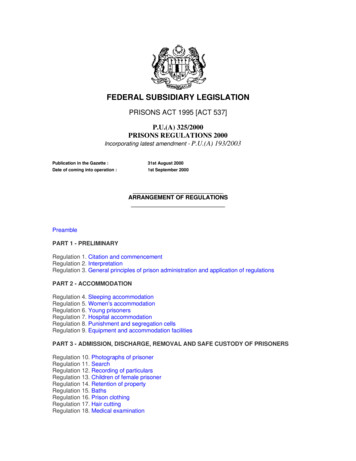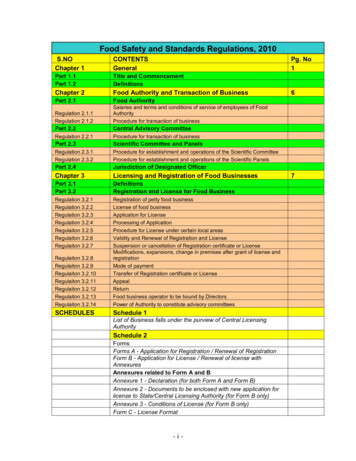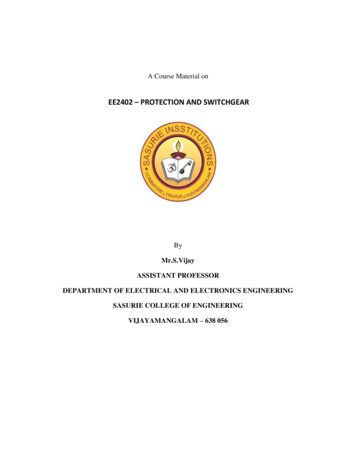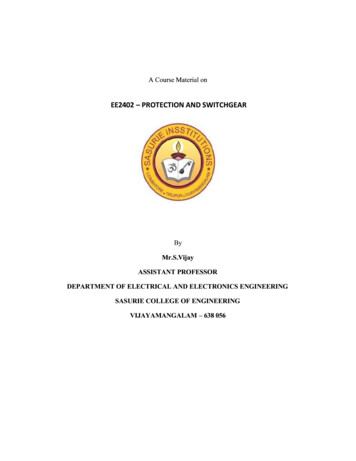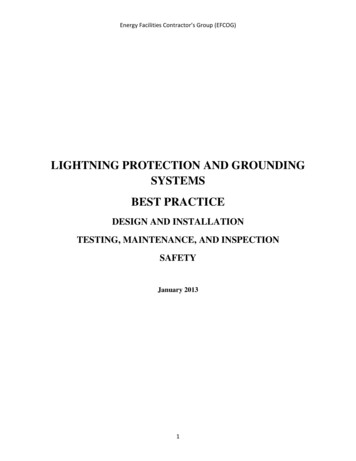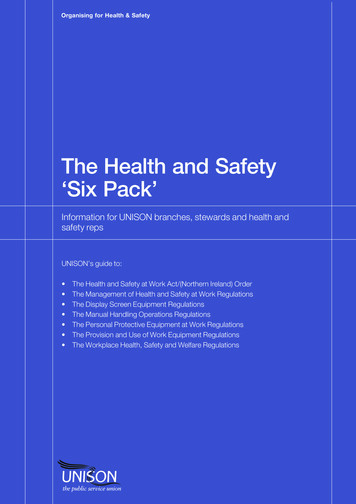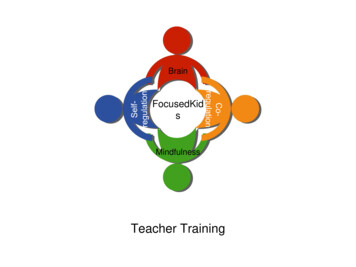
Transcription
R e g u l at o r y & m a r k e t e n v i r o n m e n tInternational Telecommunication UnionTelecommunication Development BureauR e g u l a t i o nPlace des Nationsa n dconsumer protectionCH-1211 Geneva 20Switzerlandin a convergingwww.itu.intenvironmentmPrinted in SwitzerlandGeneva, 2013arch03/2013Te l e c o m m u n i c a t i o n20D e v e l o p m e n t13S e c t o r
Regulation and consumer protectionin a converging environmentMarch 2013
This report has been prepared for ITU by Rosalind Stevens under the direction of the BDT Regulatory andMarked Environment division. Please consider the environment before printing this report. ITU 2013All rights reserved. No part of this publication may be reproduced, by any means whatsoever, without theprior written permission of ITU.
Regulation and consumer protection in a converging environmentForewordIt is my pleasure to introduce the report on the regulation and consumer protection in a convergingenvironment, in the framework of Resolution 64 of the World Telecommunication DevelopmentConference (Hyderabad, 2010) and the activities of ITU-D Study Group 1. I have championed that ITU-Dwork closely with its Membership on this topic: to help them develop good policy; to create partnershipsfor ICT investment; and, to build human capacity.The expansion of digital technologies has dramatically changed the way in which electroniccommunication services are delivered to and accessed by consumers. Broadband networks, voice, dataand video services can now be offered on the same platform. This not only promotes competition of awide variety of services and applications that was not possible before, but consequently requires newregulatory frameworks to tackle issues previously managed in the separate and distinct domains ofbroadcasting, telecommunication and online services.This report describes and analyses the various resources, strategies and tools that regulators need toimprove the enforcement of national laws, rules and regulations governing consumer protection in aconverging environment.I hope that the guidelines, recommendations and best practices for the implementation of consumerprotection policies related in this report will assist today’s multi-stakeholder efforts to address manyissues affecting present and future economic and social development.Brahima SanouDirector, TelecommunicationDevelopment Bureaui
Regulation and consumer protection in a converging environmentTable of contentsPageForeword .iTable of contents. iiiIntroduction . 1Section 1: Current regulatory frameworks in relation to consumer protection. .1Section 2: Defining the problem – what does convergence mean for regulation and consumers?.6Section 3: Critical areas for the establishment of policies or regulatory frameworks for theprotection of consumers and users in a converging environment .8Section 4: What are the organisational methods and successful practices used by NRAs toenforce their national laws, rules and regulations governing consumer protection in a convergingenvironment?. 16Section 5: Guidelines and recommendations for successful methods and practices for meetingthe challenges of convergence . 19Section 6: Summary and conclusions . 21iii
Regulation and consumer protection in a converging environmentIntroduction1With the introduction of Internet Protocol (IP) and broadband networks, voice, data and video servicescan now be offered on the same platform. This convergence has enabled inter-platform competition for awide variety of services and applications that was not previously possible. As a result, ‘traditional’telephony providers now offer video and data (Internet) services, and cable companies offer Internetaccess and voice services. Wireless networks that previously provided mainly voice services have nowbecome the primary means of Internet access in many countries.Convergence has had the following impact on services, networks, devices and companies: Services: voice, data and video services and applications can all be provided over a singleinfrastructure platform. Networks: different types of transmission systems (wire line, wireless, satellite, unlicensed) canbe linked together through IP to deliver converged services anywhere and at any time. Devices: a single device can allow access to telephone services, video streaming or broadcastingand Internet access. Companies: firms are combining in many different ways through mergers and acquisitions andvertical integration in order to respond to consumers’ demands for advanced services.Section 1: Current regulatory frameworks in relation to consumer protection.2In July 2012 the ITU-D Study Group 1 conducted a survey on consumer protection policies amongst its193 member states, focusing on convergence. The findings will help to inform conclusions of ITU-D StudyGroup 1 Question 18-2/1 for the 2010-2014 study period.A total of 37 complete entries were received in response, including two from regional/internationalorganisations and two from sector members.3 Figure 1 below illustrates the regional breakdown ofrespondents. Table 1 breaks down respondents according to development status.Figure 1: Regional breakdown of survey asAustralia/AustralasiaSource: ITU1Contribution to the Introduction of the Draft Report to Question 18-2/1, Document 1/167-E, Source: BDT Focal Point forQuestion 18-2/1, Third Meeting of ITU-D Study Group 1, Geneva, 10-14 September 2012.2Source: ITU Survey responses, and Study Group 1 Question 18-2/1 submissions.3Turk Telekom, U-COM Burundi, ARCTEL-CPLP, African ICT Consumers Network (AICN)1
Regulation and consumer protection in a converging environmentTable 1: Breakdown of responses by development statusPercentageDeveloped countries18.9Transition countries2.7Developing countries54.1Least Developed countries21.3Out of the 32 responses received from member states4 67 per cent reported having specific legislation forconsumer protection and consumer rights for telecoms/ICT consumers. By contrast, only two out of eightof respondents from Least Developed Countries (LDCs),5 Senegal and Mali have such legislation.Where legislation exists, the most commonly cited consumer related provisions are: access toinformation/transparency; quality of service; equity/right of access to services; protection of personaldata; privacy; confidentiality of information and the right to complain.Less commonly cited rights were: The right to end/change a contract (7/29, 24%) Compensation in case of service interruptions (5/29, 17%) Right to block advertisements (4/29, 14%) Access to Emergency Numbers (3/29, 10%) Portability of phone numbers (3/29, 10%)Survey respondents reported almost universal provision for consumers to have access to pricing/ratesinformation for fixed, mobile, and Internet access and services (for personal computers and smartphones). Twenty-three of the survey respondents (62%) reported playing a role in the investigation ofconsumer complaints.Consumer complaints play a valuable role in helping regulators to identify those areas where currentlegislation/regulation may be lacking and where best to target intervention. The most commonly reportedtype of complaint, cited by all survey respondents, were about pricing and billing; quality of service; andservice outages/poor coverage.A key indicator of successful consumer protection practices is the time taken to resolve consumercomplaints. This helps demonstrate the level and cost of resource required and identifies which agency isbest placed to handle the complaints. Amongst those National Regulatory Authorities (NRA) that reportedhaving a role in complaint handling, there was a fairly even distribution of the time taken to resolve thecomplaint. Around two thirds were resolved within 25 days. Three out of 16 respondents reported facingproblems and challenges with slow complaint procedures.As Figure 2 illustrates, there is considerable variation between developing and developed/transitioncountries in the type of consumer protection responsibilities undertaken. For example, regulators indeveloped countries are less likely to play a direct role in complaints handling than those in developingcountries, with responsibility for fraud protection most prevalent in least developed countries.4Those countries participating in the survey were Azerbaijan, Bahrain, Belgium, Bhutan, Bolivia, Brazil, Bulgaria,Colombia, Côte d'Ivoire, Cyprus, El Salvador, Honduras, Italy, Lithuania, Mali, Mexico, Mongolia, Oman, Portugal, Qatar,Rwanda, Senegal, South Africa, Sudan, Swaziland, Switzerland, Syria, Thailand, Tunisia, Uganda, Uruguay, Vanuatu, andVenezuela.5These are the 49 least developed countries recognized by the United Nations.2
Regulation and consumer protection in a converging environmentFigure 2: Consumer regulation activities by development statusSource: ITUOut of the 13 per cent of total telecommunication regulatory authorities (TRA) who reported having nospecific consumer protection legislation, 10 out of 17 have an alternative NRA that is empowered to applygeneral consumer protection regulations to the telecoms/ICT sector.Figure 3: National Consumer protection regulatory authorities with a remit that extends totelecoms/ICT 6Source: ITUIn almost two thirds of respondent countries, only one or two agencies are involved in consumerprotection, but in the remaining third there are three or more. Respondents reported considerablevariation in the type of consumer protection for which those agencies are responsible. In the majority ofcases the agency in question has some responsibility for consumer education and complaints: aroundthree quarters play some role in drafting legislation and just over one half have a role in law enforcement.6Data relates to survey respondents only3
Regulation and consumer protection in a converging environmentFigure 4: ICT/Telecom related responsibilities of consumer protection agenciesSource: ITUHalf of the respondents reported difficulties experienced by the agencies in enforcing consumer lawand/or encouraging consumer protection in some form. This proportion rose to three quarters amongstLDC respondents.Many respondents reported that the consumer protection agencies had structural problems including alack of expertise and human resources. Other respondents said their consumer protection legislation wasinadequate or non-existent. There were also problems around consumer education and awareness.Whereas in the majority of cases respondents reported a clear division of responsibilities between thedifferent agencies involved, just under one third reported some overlap in competencies. Where thisexists, only around one half of respondents said they had the means with which to actively shareinformation about the challenges faced. Where information is shared this is either through officialinformation sharing agreements, special papers and reports, workshops or through a governmentministry.Around the same proportion said they co-operated or co-ordinated with consumer protection agencies ona ‘needs’ only basis. This may explain why only half of respondents believed consumers found it easy toknow which agency to contact for different matters. On the other hand, this response seems to contradictthe survey finding that just over two thirds of consumers can solve their problems concerning convergedservices by contacting one agency. There was an almost even split between respondents who agreed thatconsumers should apply to different entities for their specific problems.For the most part the telecoms/ICT regulator nevertheless felt able to resolve individual telecoms/ICTrelated consumer protection issues itself, without referring the consumer to another agency.Over half of all survey respondents felt that some additional legislation to protect consumers was neededin their country, with almost two thirds reporting that consumer needs were not being servedappropriately by existing legislation, or that legislation was out of date. Almost three quarters ofrespondents felt they needed more guidelines and recommendations on consumer protection – includinghow to educate consumers and keep them informed.4
Regulation and consumer protection in a converging environmentFew respondents reported updates made to consumer legislation in their country (19 respondents).7Where this had taken place, it had been within the previous two years in over half of respondentcountries (59 per cent) and covered a number of different areas including: new user rights; increased information/transparency; data security/privacy; price regulation; and accessibility.Of those respondents reporting unique reforms, these included consumer protection guidelines (Bahrain),telecommunication employee regulation (El Salvador) and a new complaint resolution system (Senegal).A very small number of respondents (6 of out of 33) reported implementation of regulatory changes toaccommodate different aspects of converging services.8 The measures were diverse, with the only areasof overlap being price transparency (three out of eight) and technology/net neutrality (two out of eight).Unique responses included: Customer communication regulations – sales of bundled services (Colombia) Contract regulations (Colombia) Pay TV regulatory framework (Brazil) Protection of personal information (Italy) Convergence of spectrum usage (Uganda)This is a surprisingly low number given the high prevalence of converged services reported in allrespondent countries: 79 per cent have VOIP services; 52 per cent have IPTV/mobile TV services; 14 per cent have mobile payment/banking services; 21 per cent have ‘other’ converged products and services including mobile GPS-localizationservices; smart phone and tablet services; combos (pay TV, telephone and internet broadband);double play (broadband and fixed line services); triple play (broadband, fixed and restricted TVservices) and total play (broadband, fixed, mobile and restricted TV services).ITU data shows that at the end of 2012 there were still 158 separate telecom/Information andCommunication Technology (ICT) regulators worldwide – albeit many have seen their mandates expandover the past five years to include information technology and broadcasting. Telecom/ICT regulators areresponsible for regulation of Internet content in only around 16 per cent of countries (mainly in Africa,Arab States and Asia-Pacific),9 although this is double the amount reported in 2009. Telecoms/ICTregulators have broadcast regulation as part of their mandate in 18 per cent of the countries.7Six in developed countries, one in a transition country, eight in developing countries and four in least developedcountries.8Three out of four developed countries, two out of seventeen in developing countries, and one out of five in a leastdeveloped country.9According to responses provided to the annual ITU telecommunication/ICT regulatory survey.5
Regulation and consumer protection in a converging environmentFigure 5: Mandate of Regulators, worldwide, 2012Source: Trends in Telecommunication Reform Report 2010/201110A few member states have started to move towards a converged regulatory framework by mergingtelecommunication and broadcasting regulatory authorities into a single converged ICT authority.11 Theconverged regulators’ responsibilities include consumer protection, competition oversight and industryspecific regulation. Some also have a specific mandate to guarantee a certain level of consumerprotection and education alongside promoting a level playing field and monitoring quality of service.Overall the survey findings demonstrate a general lack of resource, strategies and tools available toprotect consumers in a rapidly converging environment.Section 2: Defining the problem – what does convergence mean forregulation and consumers?As outlined in the Introduction, the expansion of digital technologies and the Internet, particularly Web2.0, has dramatically changed the way in which electronic communication services are delivered andaccessed. This presents regulators with a number of challenges. These include: Encouraging investment in high-speed networks and advanced technological solutions that areuniversally available and accessible. Protecting innovators, creators and consumers from counterfeiting and piracy associated withthe online (increasingly cross-border) distribution of goods and services Promoting and safeguarding E-commerce: by creating a framework in which reliable andefficient electronic payment mechanisms (card, internet and mobile) can flourish(e.g. e-identification and trust services for e-transactions).10ITU Broadband Commission Report p.70 – The State of Broadband 2012 Achieving Digital Inclusion for report2012.pdf11These include the Tanzanian Communications Regulatory Authority (2003); The Australian Communications and MarketAuthority (ACMA) – 2005, the Bhutan Information Commission and Media Authority (2000) the MalaysianCommunications and Multimedia Commission (1998), the UK Office of Communications (Ofcom) (2003); and theIndependent Communications Authority of South Africa (ICASA) (2005).6
Regulation and consumer protection in a converging environment Ensuring consumers have all the information they need to make informed choices and haveadequate protection and redress mechanism if things go wrong. Safeguarding trust in the Internet by developing a robust cybercrime strategy and dataprotection and privacy strategy that is future proofed to cope with new technologies. Creating a simpler, clearer regulatory framework and level playing field for distributors ofcontent,12 avoiding legal uncertainty, duplication and double monitoring that may occur wherenetwork and transmission regulation is separate from content regulation.High-speed reliable networksA reliable infrastructure offering improved connectivity and speed is central to the successful delivery ofconverged services that match consumers’ expectations. This is why governments across member statesare actively promoting the use and development of broadband as a vehicle for economic and socialdevelopment and growth. This helps businesses and consumers to conduct their businesses bothdomestically and internationally, promoting digital products, services and physical products. By the end of2011, fixed broadband services were commercially available in 206 economies; and mobile broadbandservices (3G and 4G) in 160 economies.13On-line counterfeiting and piracyThe Internet has provided counterfeiters and pirates with a new and powerful means to sell theirproducts via auction sites, stand-alone e-commerce sites and email marketing. The development of newtechnologies also poses a challenge for the prevention of the unauthorised use of protected works andthe principle of copyright as the means to reward the development of and investment in creative content.Promoting and safeguarding e-commerceConsumers want easy access to the goods and services they buy online, including purchases madethrough their mobile devices. They also want assurance that their data is safe and not being used forirresponsibly or fraudulently. Trust is essential for promoting e-commerce and cross border online tradebut regulation has to be proportionate and sufficiently flexible to accommodate future innovation.Keeping consumers informed and providing redress if things go wrongGovernment, regulators and industry need to ensure consumers have access to clear information andeducation about converged services so they can make informed choices. Consumers need to understandthe type of content they are accessing and the level of regulation it is subject to. Regulators need to findways to protect consumers from harmful content and provide access to redress, particularly as servicesare increasingly delivered from outside national boundaries.Safeguarding trust in the InternetInternet traffic is doubling every 2-3 years and mobile Internet traffic every year. It is predicted that by2015 there will be 25 billion wirelessly connected devices globally; doubling to 50 billion in 2020; andmobile data traffic will increase 12 fold between 2012 and 2018, data traffic on smart phones by 14 timesby 2018. The downside of the increase in traffic is the rising threat of cybercrime, and risks to networksecurity. Trust in the Internet may be compromised by inappropriate use of personal data or risks to thesecurity of online data14.12Network operators that retransmit broadcasting signals and offer them to the public, e.g. cable or satellite operators,mobile operators, IPTV providers.13ITU survey for the creation of a compendium on telecommunication/ICT consumer protection case studies in aconverging environment, July 201214A recent Eurobarometer survey found that 40% of users were concerned about their data being compromised onlineand 38% were worried about the security of online payments (Special Eurobarometer survey 390, ‘Cyber security.’7
Regulation and consumer protection in a converging environmentFigure 6: The devices which people are using to access the Internet 2012Source: Intel, published in “The Device Wars”– in State of Broadband ReportCreating a simpler, clearer regulatory frameworkThe overall aim of regulatory policies and regulations to safeguard the public interest and protectconsumers should be to create an environment in which high quality; sustainable convergedcommunications services can flourish. This includes developing and maintaining a consistent level ofconsumer protection across different digital media environments. Having thriving legitimate onlinemarkets benefits businesses and consumers alike. Thus when considering consumer protection policies,regulators need to assess the potential impact of regulatory intervention, in terms of new or additionalburdens on business, as compared with the potential benefits for consumers.Section 3: Critical areas for the establishment of policies or regulatoryframeworks for the protection of consumers and users in a convergingenvironmentModifications to regulatory frameworks, including improved measures around enforcement andimplementation of legislation, rules, and regulations to protect consumers are needed because: Service providers that previously served different markets are now competing for the samecustomers. There are significant and on-going changes in how services, applications and content areprovided and sold to consumers.The challenge for all regulators is to understand the underlying dynamics of convergence from aconsumer perspective. For consumers, convergence is not some abstract concept that concerns networks,providers and devices – it relates to and impacts upon their behaviour and the nature of their relationshipwith their service provider. Consumers are able to interact seamlessly with their community of choice inways that suit their own personal preferences – in terms of device, timing, mode15 and medium.16 Forexample, under the umbrella of Web 2.0, many sites enable users to share multimedia content, data,experiences, views and opinions on different issues, and even to act cooperatively to solve globalproblems. In short, the traditional ‘consumer’ is shifting to becoming a ‘prosumer.’1715For example, they can communicate through a synchronous mode (telephone conversations, instant messaging or chatrooms etc) or through asynchronous mode (e-mail, blogging, text messaging, discussion boards).16Voice, data, video, and pictures17A word used to describe users that both consume and produce goods and services, attributed to Don Tapscott asdefined in “Wikinomics”, Don Tapscott, Anthony D. Williams, Wikinomics: How Mass Collaboration Changes Everything,Portfolio Trade, 2006. ISBN 1-59184-367-7.8
Regulation and consumer protection in a converging environmentFrom a service provider perspective, prosumers are a source of valuable user data that enables userprofiling, opinion mining, trend and crisis detection, and collective problem solving. Although theprosumer may be willing to transfer and exchange vast amounts of personal data online for their ownneeds, they may nevertheless feel entitled to protection against the misuse of that information includingthe right to be better informed about their rights and be in more control of that information. Theprosumer also continues to face a number of constraints in terms of pricing, choice, technical complexity,device incompatibility, service terms, and so on.Although few member states have already established policies and/or regulations to accommodateconverging services, the areas in which they have chosen to intervene include on price transparency andtechnology/net neutrality. This rationale appears to be supported by the most commonly reported typesof complaint cited by all survey respondents, which were around pricing and billing; quality of service; andservice outages/poor coverage.Other important consumer rights cited by respondents were the protection of personaldata/privacy/confidentiality of Information (9/29, 31%) and the right to complain (8/29, 28%).Net neutrality and quality of service issuesThe expression “net neutrality” usually refers to the debate around whether there should be anoverarching principle of non-discrimination regarding different forms of Internet traffic carried acrossnetworks.The net neutrality debate is typically argued from a supply-side perspective (i.e. whether networkoperators should be allowed to block or charge for prioritising an application provider’s traffic). The actualand potential massive increases in data traffic as consumers use more services and applications increasespressure on network capacity and breaks down the traditional links between end use and the associatedcosts of service provision.Although consumers may be prepared to pay more for faster Internet speeds and the ability to accessnew content and applications, unless they are able to differentiate between the various service offerings,there is considerable potential for dissatisfaction, particularly if the quality of service is degraded orcontent is blocked.The challenge for regulators is to balance a consumer’s demands for unlimited access and unrestrictedcontent against a provider’s ability to use the bandwidth available effectively and resist the temptation toblock Internet applications and content to try and control the pipeline, restrict competition and limitconsumer choice.In 2010 the Italian NRA, AGCOM, undertook an investigation into traffic management techniques relatedto VOIP and peer-to-peer (P2P) mobile applications. Following consultation with relevant stakeholders,18AGCOM is assessing whether existing transparency requirements on the quality of Internet access servicesare adequate. Current measures include the Misura Internet speed test19, used by consumers to verifyeffective speed of fixed broadband connections. If AGCOM concludes the requirements are inadequate itwill consider whether to introduce new regulatory measures to protect net neutrality. 20In June 2011 the Dutch Parliament introduced legislation to prevent the blocking or discrimination ofcertain content, services or applications. Mobile Internet providers must now allow customers to useSkype and other rival services – that enable smart phone users to send messages at no extra charge – ontheir networks without charging extra or giving preferential treatment to their own offerings.2118Undertaken in 2011 and approved with Resolution no. 713/11/CONS19www.misurainternet.it/20Document 1/162-E18 July 2012, ment-mobile-net-neutrality.html9
Regulation and consumer protection in a converging environmentIn the United Kingdom the preferred approach is to encourage self-regulation in the first instance. Undera voluntary open Internet code of practice on traffic management, Internet Service Providers (ISPs) agreeto provide full and open Internet access products and confirm that traffic management practices will notbe used to target and degrade the services of a competitor.22 The code includes Key Facts Indicators (KFI),which set out individual operator’s traffic management policies in a clear and comparable format. Theover-arching policy objective is to allow ISPs to manage their networks in a way that enables them toinnovate and develop new business models, whilst ensuring a good service for consumers. The NRA,Ofcom, has powers to intervene to ensure transparency and set minimum quality of service standards,should the market “develop in an anti-competitive or detrimental way”.23Pricing, billing and transparencyConsumer complaints about pricing and billing were the most commonly cited by survey respondents.These complaints arise despite consumers having almost universal access to pricing information across allservices, including for mobile, internet access and smart phone services. Brazil, El Salvador, South Africa,Uruguay specifically mentioned the availability of consumer information for subscription and pay TVservices
Figure 2: Consumer regulation activities by development status Source: ITU Out of the 13 per cent of total telecommunication regulatory authorities (TRA) who reported having no specific consumer protection legislation, 10 out of 17 have an alternative NRA that is empowered to apply general consumer protection regulations to the telecoms/ICT sector.
